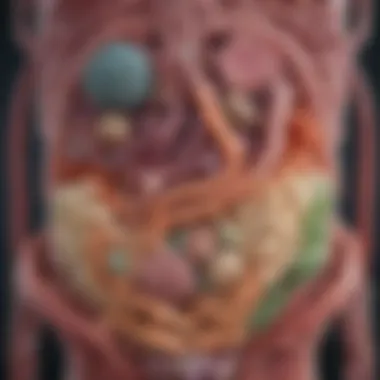Optimal Probiotics for Post-Gastroenteritis Recovery


Intro
Gastroenteritis is a condition that results in the inflammation of the stomach and intestines, leading to symptoms such as diarrhea, vomiting, and abdominal pain. This ailment can stem from various causes, including viral infections, bacterial infections, and even certain medications. After an episode of gastroenteritis, many individuals seek ways to restore their gut health. Probiotics emerge as a potential solution in this context. They are live microorganisms that provide health benefits, especially for gut flora.
Probiotics are known to support digestion, enhance gut barrier function, and regulate immune responses. However, there is a need for careful selection of the right strains that can effectively alleviate the aftermath of gastroenteritis. Not all probiotics are created equal, and understanding which ones are most beneficial is crucial for effective recovery.
This guide aims to present a thorough examination of the role of probiotics after gastroenteritis, exploring the specific strains known for their efficacy, the mechanisms through which they operate, and practical advice for both patients and healthcare professionals.
Understanding Gastroenteritis
Gastroenteritis is a common health condition that can significantly impact people, leading to discomfort and complications. Understanding the nature of gastroenteritis is essential, as it sets the foundation for exploring the best probiotics for recovery. This section will discuss definitions, causes, symptoms, and the effects on gut microbiota. Understanding these elements helps readers comprehend how the body reacts during and after the illness, and why probiotics might play a vital role in recovery.
Definition and Causes
Gastroenteritis refers to the inflammation of the stomach and intestines, often caused by infections from viruses, bacteria, or parasites. The most prevalent viral agents include norovirus and rotavirus. People can also acquire gastroenteritis from contaminated food or water, leading to outbreaks in communities. Bacteria such as Salmonella, E. coli, and Campylobacter also contribute to this condition. Understanding the specific cause is vital for treatment, as bacterial infections might require antibiotics, while viral cases generally resolve on their own.
Symptoms and Complications
The symptoms of gastroenteritis can be debilitating and may include:
- Diarrhea
- Vomiting
- Abdominal pain
- Fever
- Nausea
For most people, symptoms typically last a few days. However, complications can arise, particularly in vulnerable populations like infants, the elderly, and those with weakened immune systems. Severe dehydration is the most common complication, which can lead to hospitalization if not addressed promptly. Recognizing symptoms and understanding potential complications is crucial for effective treatment and recovery.
The Impact on Gut Microbiota
Gastroenteritis has a profound effect on gut microbiota, which consists of trillions of microorganisms living within the digestive tract. During gastroenteritis, this delicate balance can be disrupted. Diarrhea and vomiting can lead to a loss of beneficial bacteria, exacerbating the symptoms. Current studies indicate that restoring gut microbiota post-gastroenteritis is essential for full recovery. Probiotics can assist in re-establishing this balance, promoting gut health and improving overall well-being.
"Restoring gut microbiota after gastroenteritis is crucial for long-term health outcomes."
In summary, understanding gastroenteritis, its causes, symptoms, and the changes it brings to gut microbiota is vital. This knowledge prepares patients and healthcare professionals to utilize probiotics effectively for recovery.
Role of Probiotics
The role of probiotics in the recovery process after gastroenteritis is crucial. Probiotics are live microorganisms that, when consumed in adequate amounts, confer health benefits to the host. This is especially significant following gastroenteritis, as the condition can disrupt the balance of gut microbiota. With antibiotic treatments often prescribed during or after such infections, the beneficial bacteria can be further diminished. Hence, understanding the nature and function of probiotics provides a foundation for their effective use in recovery.
What Are Probiotics?
Probiotics are often referred to as "good" or "friendly" bacteria. They exist in various forms including dietary supplements and fermented foods such as yogurt and kefir. The specific strains of probiotics are critical, as not all have the same benefits. Common strains include Lactobacillus and Bifidobacterium, which are known for their roles in promoting gut health.


The consumption of probiotics aims to restore the natural balance of the gut microbiota that may be altered due to infections, dietary shifts, or antibiotic use. They are increasingly recognized as an important component in managing gastrointestinal disorders.
Mechanisms of Action
Understanding the mechanisms of action of probiotics highlights their therapeutic potential. One fundamental action of probiotics is their ability to adhere to intestinal mucosa. By occupying this space, they prevent pathogenic bacteria from attaching and proliferating.
Additionally, probiotics enhance the barrier function of the intestinal lining. This is vital because a compromised intestinal barrier can lead to increased permeability, allowing toxins and pathogens to enter the bloodstream. Furthermore, probiotics produce short-chain fatty acids through fermentation of dietary fibers. These fatty acids contribute to gut health and can have anti-inflammatory effects.
Benefits of Probiotics
The benefits of probiotics extend beyond mere restoration of gut flora. Some notable benefits include:
- Reduction of Diarrhea: Probiotics can significantly reduce the duration and severity of diarrhea caused by gastroenteritis. Studies have shown that certain strains, like Saccharomyces boulardii, are effective in preventing antibiotic-associated diarrhea.
- Strengthening Immune Response: Probiotics can enhance the gut-associated lymphoid tissue, promoting a more robust immune response against pathogens.
- Gut Health Maintenance: Regular intake of probiotics can help maintain a diverse microbiota, which is essential for overall gastrointestinal health.
Research indicates that probiotics can help to rapidly restore gut microbiota, providing a vital function post-gastroenteritis.
In summary, the role of probiotics in recovery after gastroenteritis is multifaceted, involving demonstration of efficacy through various biological mechanisms. As the body attempts to regain its balance, the timely introduction of the right probiotic strains can be instrumental in supporting gut health and aiding recovery.
Selecting the Best Probiotics Post-Gastroenteritis
Choosing the right probiotics after gastroenteritis is crucial for recovery. The condition often disrupts the gut flora, leading to an imbalance that can affect digestion and overall health. Probiotics serve as beneficial bacteria that help restore this imbalance. They can enhance recovery by improving gut function and potentially reducing the duration of symptoms such as diarrhea.
When selecting probiotics, several factors should be considered. These include the specific strains of probiotics, their efficacy based on clinical evidence, and proper dosage. Understanding these aspects can significantly influence recovery outcomes.
Key Strains for Recovery
Not all probiotics are created equal. Specific strains have shown significant promise in aiding recovery from gastroenteritis. Some of the noteworthy strains include:
- Lactobacillus rhamnosus GG: This strain is well-documented for its role in combating diarrhea and restoring gut health.
- Saccharomyces boulardii: A probiotic yeast that has been effective for treatment of acute gastroenteritis, particularly in children.
- Lactobacillus reuteri: This strain has shown potential in reducing the duration of severe diarrhea and improving gut function.
These strains have undergone various studies highlighting their ability to effectively support recovery from gastroenteritis. It’s important to look for probiotics containing these specific strains to maximize benefits.
Clinical Evidence and Guidelines
Research supports the effectiveness of probiotics in managing gastroenteritis symptoms. Clinical guidelines often recommend using specific strains, particularly after antibiotic use, to help restore gut flora.
The World Gastroenterology Organisation has highlighted that some strains can reduce the duration of diarrhea caused by infections. Meta-analyses indicate that children who received probiotics after gastroenteritis experienced shorter hospital stays and improved recovery times. Health professionals recommend considering probiotics as an adjunct therapy, particularly in vulnerable populations like children and the elderly.
Probiotic Dosage Recommendations
Proper dosage of probiotics post-gastroenteritis can significantly impact recovery. It is typically recommended to follow the instructions provided by healthcare professionals or the product label. Suggested dosages can vary:


- For adults: Generally, taking 5 to 10 billion CFUs (colony-forming units) per day is effective.
- For children: A lower dosage, around 1 to 5 billion CFUs per day, may be suitable depending on their age and size.
Exceeding the recommended dosages is not advisable, as higher amounts do not always lead to better results. Regular monitoring during the use of probiotics can help in assessing their effectiveness. Safe and responsible usage is key to optimizing gut health recovery after gastroenteritis.
Probiotic Sources
Understanding sources of probiotics is crucial for individuals recovering from gastroenteritis. The gut microbiome can be significantly impacted during episodes of gastroenteritis. Probiotics can aid in restoring balance, but the form in which they are consumed can influence their effectiveness.
Supplemental Vs. Food-Based Probiotics
Probiotics can be obtained either through supplements or from food sources. Each option offers distinct benefits and considerations.
Supplements often come in capsules, powders, or liquids. They can provide high concentrations of specific strains of bacteria. This can be beneficial for targeted recovery goals. Supplements are also convenient and can be taken easily. However, not all supplements are created equal. Quality varies among brands and formulations. It is important to select a reputable product. Look for clinical studies that back the strains used in the supplement.
Food-based probiotics, on the other hand, integrate well into a regular diet. They are found in items such as yogurt, kefir, sauerkraut, kimchi, and miso. They offer the added benefit of other essential nutrients that food provides. Ingesting food sources may also be more acceptable and pleasant for some individuals compared to taking a pill. Additionally, natural sources may introduce a broader spectrum of bacteria, which can enhance diversity in the gut microbiome. However, the concentrations of probiotics in food are often much lower than in supplements, requiring greater quantities to achieve specific health benefits.
In deciding between the two, individuals should consider their dietary preferences, lifestyle, and recovery goals. Consulting a healthcare professional can provide personalized advice based on individual needs.
Commercial Probiotic Products
In the market, various commercial probiotic products exist. These products can range from supplements to fermented foods. When seeking effective probiotics, it's essential to scrutinize these products closely.
Key factors to consider include:
- Strains: Identify specific strains that have evidence supporting their efficacy in post-gastroenteritis recovery, such as Lactobacillus rhamnosus GG or Saccharomyces boulardii.
- CFU Count: CFUs, or colony-forming units, indicate the number of viable bacteria. Choose products with sufficient CFUs for therapeutic effects.
- Quality Assurance: Look for certifications that ensure manufacturing standards and product quality. Labels from organizations such as USP or NSF can be indicators of reliability.
- Storage Instructions: Some products require refrigeration, while others have stable formulations. Proper storage is important to maintain the probiotic's viability.
- Expiration Dates: Always check the expiration date to ensure the probiotics are effective when consumed.
"Selecting high-quality probiotics is essential for restoring gut health, especially after gastrointestinal disturbances."
Ultimately, both supplemental and food-based probiotics have value. The choice largely depends on individual preferences and situations. Ensuring proper sources of probiotics is a key step in achieving optimal gut health after gastroenteritis.
Administration and Considerations
The administration of probiotics post-gastroenteritis is a vital aspect of recovery. Understanding when and how to use them can substantially impact their effectiveness. The timing and duration of probiotic intake are crucial factors that can enhance or hinder the restoration of gut health. Moreover, potential side effects and contraindications need to be considered by individuals as well as healthcare professionals to ensure safe use.
Timing and Duration of Use
The timing of probiotic administration influences how well these beneficial microorganisms establish themselves in the gut. Starting probiotics during the recovery phase, rather than after full recovery, can support the gut environment before it reaches optimal health. Clinical studies indicate that initiating probiotic treatment as soon as symptoms of gastroenteritis diminish can be beneficial. The duration of use is also significant. Generally, continuing probiotics for at least two to four weeks post-recovery is recommended. This allows sufficient time for gut flora rehabilitation and stability. Patients must be encouraged to maintain consistent usage to allow the beneficial strains to populate effectively.
Potential Side Effects and Contraindications


While probiotics are generally considered safe, there are potential side effects. Some individuals may experience mild gastrointestinal symptoms such as gas or bloating, especially when first starting a new probiotic regimen. These effects usually resolve as the body adjusts. However, serious contraindications exist, particularly for immunocompromised individuals. > "Individuals with compromised immune systems must consult healthcare professionals before using probiotics, as they may carry risks of infections related to probiotic strains."
It is crucial to assess each person's health status and possible contraindications before recommending specific probiotics. Awareness and education on these aspects can greatly influence the safe and effective use of probiotics in recovery from gastroenteritis.
Future Perspectives
The exploration of probiotics after gastroenteritis opens intriguing avenues for future research and application. This section examines vital aspects of ongoing studies and the potential for expanded usage of probiotics. These insights are essential for not only enhancing our understanding but also for refining clinical practices and recommendations regarding probiotics in recovery scenarios.
Ongoing Research in Probiotics
Current research is consistently revealing the complex interactions between probiotics and human health. Investigators are delving into specific strains, such as Lactobacillus and Bifidobacterium, to assess their efficacy in restoring gut health after illnesses like gastroenteritis. As clinical trials progress, they aim to establish clearer guidelines on which probiotic strains are most effective for different symptoms, enabling targeted treatment. The focus on individual responses to probiotic interventions is critical. It highlights how genetic factors, diet, and existing microbiota may shape the outcomes, leading to more personalized approaches in therapy.
Moreover, advances in genomics and microbiome analyses are providing insights into the mechanisms by which probiotics exert their effects. For instance, studies are showing that specific probiotic strains may enhance the production of short-chain fatty acids, which are vital for gut health. These discoveries contribute to a body of evidence that better informs clinicians when recommending probiotics to patients recovering from gastroenteritis.
"Developing insights into the precision of probiotic strategies promises to elevate standard recovery protocols."
Expanding Applications Beyond Gastroenteritis
The applications of probiotics extend well beyond gastroenteritis recovery. Emerging studies indicate potential uses in various gastrointestinal disorders, including irritable bowel syndrome and inflammatory bowel disease. Further, probiotics are being investigated for their role in mental health, given the link between gut health and mood regulation. This expansion signifies that probiotics could become integral in preventative health strategies.
Additionally, insights from gastroenteritis recovery are being integrated into these broader uses. For example, understanding the importance of gut microbiota balance after an infection provides foundational knowledge for using probiotics in diverse contexts. As research continues to unfold, practitioners will likely find that probiotics play a proactive role in maintaining gut health, thus preventing future complications.
In summary, the future of probiotics appears promising. With ongoing research and expanding applications, there is substantial potential for probiotics to improve health outcomes in various areas. This evolution emphasizes the need for continual learning and adaptation within the healthcare community.
Practical Recommendations for Use
Probiotics play a significant role in recovery after gastroenteritis. This condition can disrupt gut microbiota balance. Therefore, proper recommendations for their use can greatly enhance recovery. This section outlines crucial practices to follow for achieving optimal benefits from probiotics.
Consulting Healthcare Professionals
It is essential to involve healthcare professionals in the decision-making process. They understand individual health needs and can provide personalized recommendations tailored to specific conditions. For example, patients with underlying health issues may require customized probiotic strains. Moreover, healthcare providers stay updated on the latest research in probiotics. This means they can suggest products or strains known to provide real benefits post-gastroenteritis.
Key Points to Consider During Consultation:
- Review medical history and current medications.
- Discuss any allergies to probiotic components.
- Ask about specific strains recommended for recovery.
- Inquire about potential interactions with existing treatments.
Monitoring Recovery and Adjusting Use
Monitoring recovery is vital for determining the effectiveness of probiotics. It helps identify any need for adjustments in dosage or type of probiotic. Patients should pay attention to how their body responds after starting probiotic intake. Common indicators of recovery may include a reduction in gastrointestinal symptoms, improved digestion, or an increase in energy levels.
"Regular feedback regarding your body’s response to probiotics can inform necessary adjustments."
Ways to Monitor Recovery:
- Keep a journal of symptoms and daily wellness.
- Note any changes in bowel habits.
- Track overall energy levels and appetite.
Based on observations, adjustments may involve changing the probiotic strain or modifying the dosage. This tailored approach maximizes the potential benefits of probiotics, ensuring a more effective recovery process for individuals affected by gastroenteritis.



